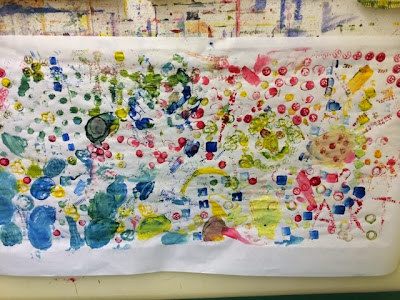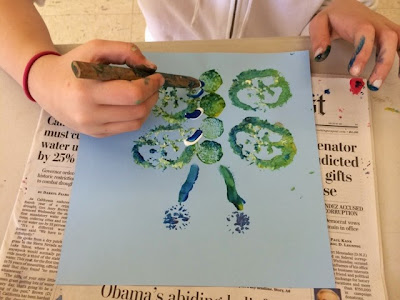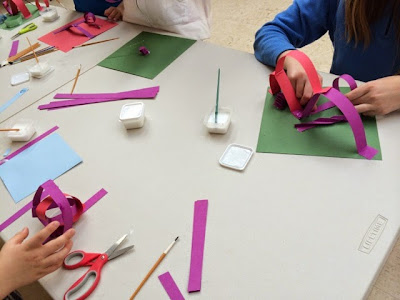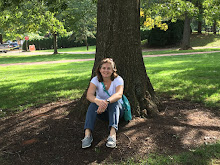Great family art event yesterday at St Aidan's Episcopal Day School.
I begin with this photo from our blocks set up in the children's studio space. The blocks out on the table invited parents and children to build and then to draw designs inspired by their buildings.
I begin with this image also because an important part of our afternoon was another kind of building - building community through creating together.
Our collage station included inviting mixtures of recycled papers, fibers and small objects. Glue in shallow containers with a small brush offered optimal control for young artists. A drop of blue paint in the glue gave it a bit of color and surprise.
Putting out materials for art reminded me of setting a table for a meal - for each material there is a place setting with specific tools and utensils as well as shared items. In the case of collage, individual artists choose their own base paper and then share in communal collections of paper and objects. The small pots of glue placed around the table can be used individually or shared between a couple of makers. Setting things up so that supplies are shared (similar to setting the table for "family style" service) is a key part of facilitating community art.
At our stamping station, artists were invited to explore different everyday objects for printing with paint.
This printing was extended with an opportunity to work more communally on a larger piece of paper at a group stamped mural.
These two stations worked together for community sharing and inspiration. Some artists were more comfortable trying things out on their own paper before joining a group creation. Others enjoyed being part of the group creation and getting ideas from what they saw there before creating an individual piece.
To take advantage of the nice day, we had a bucket of recycled CD's outside for designing on the grass. These young artists made trails and tracks with the shiny CDs. For great CD art inspiration, see the website of artist
Bruce Munro.
Stampers at work ...
Busy hands of collage artists...
And a growing group stamping mural...
One of my favorite aspects of community art is noticing how strategies are developed and shared. After watching artists make dots and drag lines with the comb, it was fun to watch this artist use the side of the teeth to stamp grass to begin his image.
Community art is also a great chance to see many developmental stages of making side by side. This older sister explored representation and symmetry with her butterfly created from stamped shapes.
At the same table younger artists explore shape and color with repetition and energy. Sharing space in mixed age settings allows for great sharing of ideas in community.
At another table, older siblings began making 3D collage creations using strips of paper.
This grew as others joined in, finding many inventive ways to twist, tie and curl paper to make architectural creations.
The arches below layer and parts build on other parts. In the same way, it is fun to watch strategies build on each other.
Finished community art works took two forms: below a collage quilt allows varied individual pieces to come together to create a group piece.
For stamping, the community art was created in layers with artists working with and around other artists to add to a group mural. It was fun to watch this one grow and change as artists filled in spaces left by others and added new shapes, marks, and patterns. Can you find the word art from the beginning photo at the top of the page?

Many thanks to all who participated and the many hands that helped with set up and clean up. It was great to watch people collaborate around tables. Reflecting on our afternoon, I noted great individuality in invention and creativity. There was also a sense of calm and intention as artists worked in the different spaces. I enjoyed the energy of the makers, the sharing of ideas and the wonderful color and invention of our new creations.

































